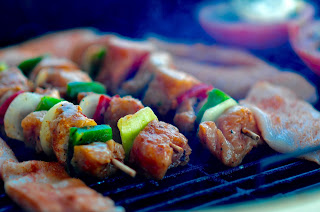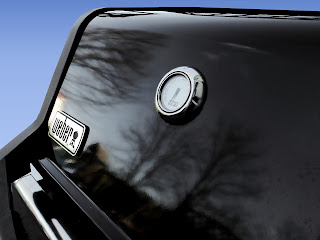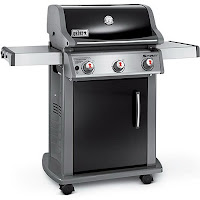How To Use A Gas Grill (An Easy Guide)
Newcomers to the world of barbecuing are in for a treat when it comes...
...to the choices available and the ease with which an outdoor meal can be prepared.
Functionality, cleanliness, and ease of use are why a propane-fueled grill...
....can be the answer to a bar-b-que master’s dilemma avoiding charcoal grit...
...potentially hazardous sparks or rental restrictions by landlords.
Gone are the days of clearing brush, stone bbq rings, wood gathering and tossing meat into the pit.
Grilling can be satisfying allowing you the pleasure of being outdoors, entertaining in a group setting...
...and preparing meals that normally not suited for indoor cooking.
Grillers who know how to use a gas grill are aware that throwing a marinated shrimp...
...on the "barbie" is a tasty meal when grates are properly preheated.
Just as seasoning your food is important preheating for 10-15 minutes on a medium heat...
...eliminates undercooked food and allows those satisfying grill marks on a juicy steak.
By oiling grates, and knowing how to use a gas grill, you prolong their life eliminating rust...
...and making them easier to clean prior to use and afterward discouraging cross contamination to your food.
Topics covered in the manufacturer's handbook regarding your grill are vital reading as guidelines should be adhered to when using your appliance.
This handy-dandy booklet covers safely starting your grill, testing for gas leaks, and even cleaning.
Most manufacturers have replacement owner’s manuals available if you’ve purchased your grill second hand.
...propane tank containing 4.5 pounds of propane and weighing about 37 pounds when full.
Propane tanks are refillable and conveniently exchangeable at local retail outlets.
Always be sure to check the seal and tank for damage or cracks, and if any, return for a replacement.
You can weigh your propane tank to see how full it is or you can feel it...
...normally the cooler area is where the propane is and the warmer area is where it is empty.
...and ensuring that the gas valve on the propane tank is closed by turning the valve clockwise to a full stop.
Next, you want to remove the seal from the propane tank making sure to use the cap and strap that are supplied with the valve.
After that, while you're holding the regulator, insert the nipple into the valve.
Use only your hand to tighten the coupling nut to the tank valve, no other tools should be needed for this...
...and ensure the regulator is aligned so the connection isn’t cross threaded.
Turn the coupler clockwise and tighten it to a full stop. Your grill should be ready now, and you can start grilling up some delicious meals!
...to the choices available and the ease with which an outdoor meal can be prepared.
Functionality, cleanliness, and ease of use are why a propane-fueled grill...
....can be the answer to a bar-b-que master’s dilemma avoiding charcoal grit...
...potentially hazardous sparks or rental restrictions by landlords.
Gone are the days of clearing brush, stone bbq rings, wood gathering and tossing meat into the pit.
Why You Should Grill...
Adequate space allowing chef's ease of functionality, movement and, maneuverability around the grilling area is advisable.Grilling can be satisfying allowing you the pleasure of being outdoors, entertaining in a group setting...
...and preparing meals that normally not suited for indoor cooking.
Grillers who know how to use a gas grill are aware that throwing a marinated shrimp...
...on the "barbie" is a tasty meal when grates are properly preheated.
Just as seasoning your food is important preheating for 10-15 minutes on a medium heat...
...eliminates undercooked food and allows those satisfying grill marks on a juicy steak.
By oiling grates, and knowing how to use a gas grill, you prolong their life eliminating rust...
...and making them easier to clean prior to use and afterward discouraging cross contamination to your food.
Start With Your Owner's Manual...
Knowing how to use a gas grill properly is important...Topics covered in the manufacturer's handbook regarding your grill are vital reading as guidelines should be adhered to when using your appliance.
This handy-dandy booklet covers safely starting your grill, testing for gas leaks, and even cleaning.
Most manufacturers have replacement owner’s manuals available if you’ve purchased your grill second hand.
Your Propane Tank Size...
Typical tank size for home grilling, turkey fryers and, outdoor space heaters would be a 20-pound......propane tank containing 4.5 pounds of propane and weighing about 37 pounds when full.
Propane tanks are refillable and conveniently exchangeable at local retail outlets.
Always be sure to check the seal and tank for damage or cracks, and if any, return for a replacement.
You can weigh your propane tank to see how full it is or you can feel it...
...normally the cooler area is where the propane is and the warmer area is where it is empty.
How To Attach The Propane Tank...
Attaching the propane tank to your grill is accomplished by making sure all grill knobs are turned to the off position......and ensuring that the gas valve on the propane tank is closed by turning the valve clockwise to a full stop.
Next, you want to remove the seal from the propane tank making sure to use the cap and strap that are supplied with the valve.
After that, while you're holding the regulator, insert the nipple into the valve.
Use only your hand to tighten the coupling nut to the tank valve, no other tools should be needed for this...
...and ensure the regulator is aligned so the connection isn’t cross threaded.
Turn the coupler clockwise and tighten it to a full stop. Your grill should be ready now, and you can start grilling up some delicious meals!






Comments
Post a Comment